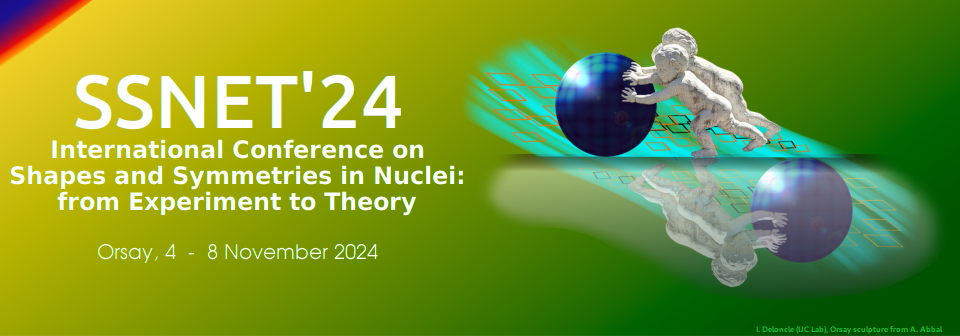Orateur
Description
The rotation of deformed nuclei generates easily recognizable patterns of excited nuclear states, called rotational bands. If the nucleus has axial asymmetry, the rotational bands are more complex, for instance, in addition to the ground-state band of an even-even nucleus, excited gamma bands are created. These sets of bands are formed because the nucleus rotates simultaneously around its three axes, a motion that looks like tilted precession (TiP) of the total angular momentum around the axis with largest moment of inertia (MoI).
The most unambiguous way to establish the axial asymmetry of the nuclear shape are direct Kumar-Cline measurements carried out within multi-step Coulomb excitation experiments. While such an analysis is model-independent and in general is the most robust proof of stable axial asymmetry, the technique is experimentally challenging and have been carried out only for a limited number of deformed nuclei. In these circumstances, the axial asymmetry of the nuclear shape is often derived based on observed features of rotational bands and on theoretical expectations, for instance energy staggering in the gamma band of even-even nuclei, tilted precession and wobbling in odd-mass nuclei, chiral bands, and others. In this presentation an alternative way of deducing axial asymmetry will be presented and discussed.
The presentation also aims at a discussion of the terminology of “wobbling” [1] and “tilted precession” [2]. Wobbling was introduced by Bohr and Mottelsson as a harmonic vibration coupled to a simple one-dimensional rotation [1]. They used a harmonic approximation of the three-dimensional rotational Hamiltonian at high spins, where the TiP motion is dominated by the rotation around the axis with largest MoI, while the tilt of the precession can be considered as caused by harmonic vibrational excitations. The motion was called wobbling, and the bands were labelled by the number of excited vibrational phonons.
However, in the last decade, bands at low spins, where the harmonic approximation does not hold and thus the bands have purely rotational character, were also associated with wobbling [3]. Such a modification in the meaning of the term “wobbling” causes conflicts with past research works. For instance, the gamma bands at low spins produced by the triaxial rotor model would, within such changed terminology, qualify as wobbling bands. This is in contrast with the past, where such low-spin bands were not considered wobbling. The differences between wobbling within its original definition (simple rotation coupled to harmonic vibration) and TiP (three-dimensional rotation causing precession) will be detailed, the terminology issues will be discussed, and a way forward will be proposed [4].
References:
[1] A. Bohr and B. Mottelson, Nuclear Structure Volume II, (W. A. Benjamin, New York, 1975).
[2] E. A. Lawrie, O. Shirinda, and C. M. Petrache, Phys. Rev. C 101, 034306 (2020).
[3] S. Frauendorf and F. Dönau, Phys. Rev. C 89, 014322 (2014).
[4] E.A. Lawrie, Chapter 6 in “Chirality and Wobbling” by C. M. Petrache, Edited by Taylor & Francis Group, 2024.

